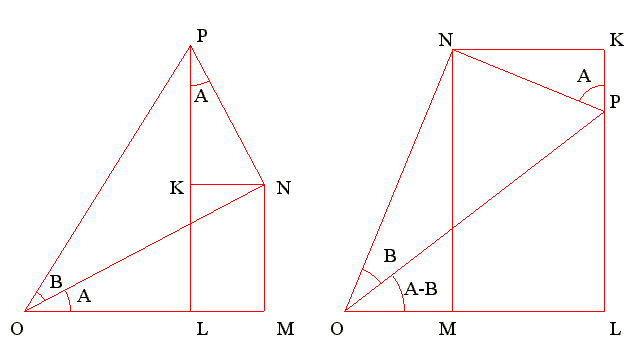Figure 322 : Angle (A+B) and (A-B)
Q01. Diagram : Angle (A + B) and angle (A - B)

|
Go to Begin
Q02. sin(A+B) = sin(A)*cos(B) + cos(A)*sin(B)
Proof
- Diagram 322 : Angle (A+B)
- PN perpendicular to ON and NK perpemdicular to PL.
- Right triangle ONP.
- NP = OP*sin(B) and NO = OP*cos(B).
- Right triangle OPL
- sin(A+B) = PL/OP = (PK + KL)/OP = (PK + MN)/OP.
- PK = NP*cos(A) = OP*sin(B)*cos(A).
- MN = ON*sin(A) = OP*cos(B)*sin(A).
- sin(A+B) = sin(A)*cos(B) + cos(A)*sin(B).
- sin(075) = sin(30+ 45) = sin(30)*cos(45) + cos(30)*sin(45) = ?
- sin(105) = sin(180-75) = +sin(75)
- sin(255) = sin(180+75) = -sin(75)
- sin(285) = sin(360-75) = -sin(75)
- Lim[sin(x+h) - sin(x))/h] = cos(x) as h tends to 0.
Go to Begin
Q03. cos(A+B) = cos(A)*cos(B) - sin(A)*sin(B)
Proof
- Diagram : Angle (A+B)
- PN perpendicular to ON and NK perpemdicular to PL.
- Right triangle ONP
- NP = OP*sin(B) and NO = OP*cos(B).
- Right triangle OPL
- cos(A+B) = OL/OP = (OM - LM)/OP = (OM - KN)/OP.
- KN = NP*sin(A) = OP*sin(B)*sin(A).
- OM = ON*cos(A) = OP*cos(B)*cos(A).
- cos(A+B) = cos(A)*cos(B) - sin(A)*sin(B).
- cos(075) = cos(30+ 45) = cos(30)*c0s(45) - cos(30)*sin(45) = ?
- cos(105) = cos(180-75) = -cos(75)
- cos(255) = cos(180+75) = -cos(75)
- cos(285) = cos(360-75) = +cos(75)
Go to Begin
Q04. sin(A-B) = sin(A)*cos(B) - cos(A)*sin(B)
Proof
- Diagram 322 : Angle (A-B)
- PN perpendicular to ON and NK perpemdicular to PL.
- Right triangle ONP.
- NP = OP*sin(B) and NO = OP*cos(B).
- Right triangle OPL
- sin(A-B) = PL/OP = (KL - PK)/OP = (MN - OK)/OP.
- PK = NP*cos(A) = OP*sin(B)*cos(A).
- MN = ON*sin(A) = OP*cos(B)*sin(A).
- sin(A-B) = sin(A)*cos(B) - cos(A)*sin(B).
- sin(015) = sin(45- 30) = sin(30)*c0s(45) + cos(30)*sin(45) = ?
- sin(165) = sin(180-15) = +sin(15)
- sin(195) = sin(180+15) = -sin(15)
- sin(345) = sin(360-15) = -sin(15)
Go to Begin
Q05. cos(A-B) = cos(A)*cos(B) + sin(A)*sin(B)
Geometric method
- Diagram 322 : Angle (A-B)
- PN perpendicular to ON and NK perpemdicular to PL.
- Right triangle ONP
- NP = OP*sin(B) and NO = OP*cos(B).
- Right triangle OPL
- cos(A-B) = OL/OP = (OM + LM)/OP = (OM + KN)/OP.
- KN = NP*sin(A) = OP*sin(B)*sin(A).
- OM = ON*cos(A) = OP*cos(B)*cos(A).
- cos(A+B) = cos(A)*cos(B) + sin(A)*sin(B).
- Construction
- Draw a unit circle with OX = 1.
- Draw point P and Q on circle. OP = OQ = 1.
- Angle XOP = A and XOQ = B
- Angle POQ = A - B
- Distance = AB = d
- Proof
- By cosine law
- d^2 = 1^2 + 1^2 - 2*1*1*cos(A-B)
- d^2 = 2 - 2*cos(A-B)
- Find distance between P and Q
- Coordinate P(cos(A), sin(A))
- Coordinate Q(cos(B), sin(B))
- d^2 = (cos(A)-cos(B))^2 + (sin(A)-sin(B))^2
- Since cos(A)^2 + sin(A)^2 = 1 and cos(B)^2 + sin(B)^2 = 1
- After expansion
- d^2 = 2 - 2*cos(A)*cos(B) - 2*sin(A)*sin(B)
- Hence cos(A-B) = cos(A)*cos(B) + sin(A)*sin(B)
- By cosine law
- cos(015) = cos(45- 30) = cos(30)*cos(45) + sin(30)*sin(45) = ?
- cos(165) = cos(180-15) = -cos(15)
- cos(195) = cos(180+15) = -cos(15)
- cos(345) = cos(360-15) = +cos(15)
Go to Begin
Q06. tan(A+B) and tan(A-B)
Prove that tan(x+y) = (tan(x) + tan(y))/(1 - tan(x)*tan(y)).
- tan(A+B) = (sin(A)*cos(B) + cos(A)*sin(B))/(sin(A)*cos(B) os(A)*cos(B)).
- Divide numerator and denominator by cos(A)*cos(B).
- tan(A+B) = (sin(A)/cos(A) + sin(B)/cos(B))/(1 - (sin(A)/cos(A))*(sin(B)/cos(B))).
- tan(A+B) = (tan(A) +tan(B))/(1 - tan(A)*tan(B)
- tan(A-B) = (sin(A)*cos(B) - cos(A)*sin(B))/(sin(A)*cos(B) + cos(A)*cos(B)).
- Divide numerator and denominator by cos(A)*cos(B).
- tan(A-B) = (sin(A)/cos(A) - sin(B)/cos(B))/(1 + (sin(A)/cos(A))*(sin(B)/cos(B))).
- tan(A-B) = (tan(A) - tan(B))/(1 + tan(A)*tan(B)
- tan(075) = tan(30+ 45) = (tan(30) + tan(45))/(1 - tan(30)*tan(45)) = ?
- tan(105) = tan(180-75) = -tan(75)
- tan(255) = tan(180+75) = +tan(75)
- tan(285) = tan(360-75) = -tan(75)
- tan(015) = tan(45- 30) = (tan(45) - tan(30))/(1 + tan(30)*tan(45)) = ?
- tan(165) = tan(180-15) = -tan(15)
- tan(195) = tan(180+15) = +tan(15)
- tan(345) = tan(360-15) = -tan(15)
Go to Begin
Q07. Find cos(A-B) using cosine law and distance formuls
Use cosine law and distance formuls
Construction
- Draw a unit circle with OX = 1.
- Draw point P and Q on circle. OP = OQ = 1.
- Angle XOP = A and XOQ = B
- Angle POQ = A - B
- Distance = AB = d
- By cosine law
- d^2 = 1^2 + 1^2 - 2*1*1*cos(A-B)
- d^2 = 2 - 2*cos(A-B)
- Find distance between P and Q
- Coordinate P(cos(A), sin(A))
- Coordinate Q(cos(B), sin(B))
- d^2 = (cos(A)-cos(B))^2 + (sin(A)-sin(B))^2
- Since cos(A)^2 + sin(A)^2 = 1 and cos(B)^2 + sin(B)^2 = 1
- After expansion
- d^2 = 2 - 2*cos(A)*cos(B) - 2*sin(A)*sin(B)
- Hence cos(A-B) = cos(A)*cos(B) + sin(A)*sin(B)
- Diagram and examples : Find sin(A+B) and sin(A-B)
Go to Begin